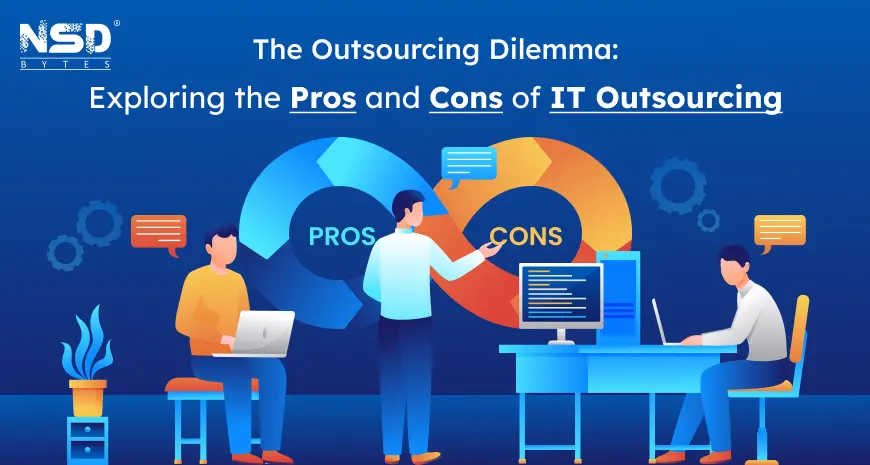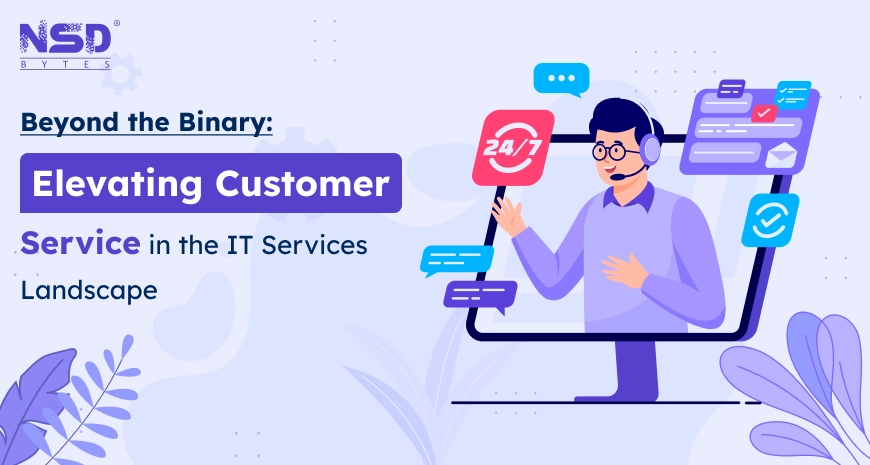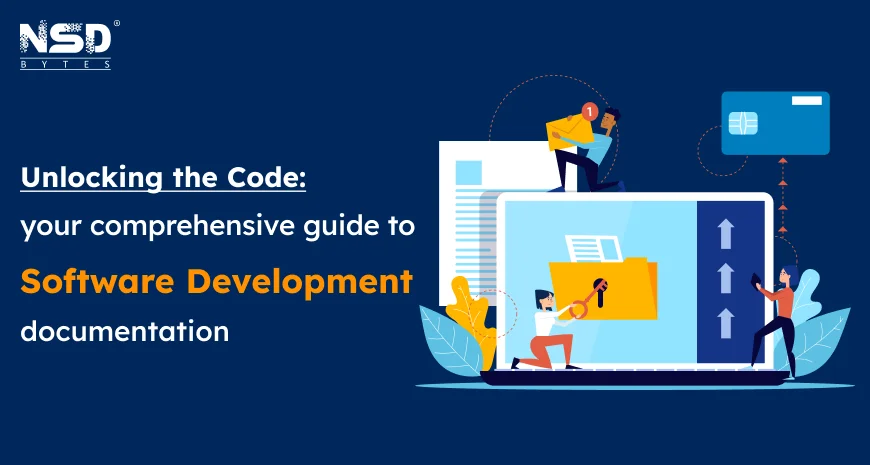
In today's fast-paced digital world, businesses are constantly seeking ways to optimize their operations and stay ahead of the competition. One strategy that has gained significant traction is IT outsourcing. By entrusting certain IT functions to external service providers, companies can focus on their core competencies while leveraging specialized expertise and resources. However, like any business decision, IT outsourcing comes with its own set of pros and cons that must be carefully considered.
Introduction:
In this comprehensive guide, we'll delve into the world of IT outsourcing, exploring its advantages, disadvantages, and key considerations for businesses looking to embark on this journey.
Pros of IT Outsourcing:
1. Cost Efficiency:
Outsourcing IT services can lead to significant cost savings for businesses. By partnering with external service providers, companies can avoid the expenses associated with hiring and training in-house staff, as well as investing in infrastructure and technology. Outsourcing allows businesses to access high-quality services at a fraction of the cost compared to maintaining an in-house team. Additionally, outsourcing providers often operate in regions with lower labor costs, further enhancing cost efficiency. This cost predictability enables businesses to allocate their budgets more effectively and invest in other areas of their operations.
2. Access to Specialized Expertise:
One of the most significant advantages of IT outsourcing is gaining access to specialized expertise. External service providers typically have teams of skilled professionals with in-depth knowledge and experience in various technologies and domains. Whether it's software development, cybersecurity, cloud computing, or data analytics, outsourcing partners bring specialized skills and capabilities to the table. This access to specialized expertise enables businesses to leverage the latest technologies and best practices without the need for extensive training or recruitment efforts. It also allows companies to stay competitive in an ever-evolving digital landscape by tapping into niche areas of expertise.
3. Focus on Core Competencies:
Outsourcing non-core IT functions allows businesses to focus their resources and attention on activities that directly contribute to their core business objectives. By delegating routine or specialized IT tasks to external providers, companies can streamline their operations and concentrate on strategic initiatives that drive growth and innovation. Outsourcing enables businesses to offload time-consuming and resource-intensive tasks, such as IT maintenance, support, and infrastructure management, freeing up internal teams to focus on value-added activities. This focus on core competencies enhances operational efficiency, agility, and competitiveness in the marketplace. It also enables businesses to adapt more quickly to changing market conditions and customer demands, ultimately driving business success.
Cons of IT Outsourcing:
1. Communication Challenges:
One of the primary challenges associated with IT outsourcing is managing communication effectively between the business and the external service provider. With teams often located in different geographical locations and time zones, communication can become fragmented, leading to misunderstandings, delays, and inefficiencies. Cultural differences and language barriers may further exacerbate these challenges, making it difficult to align expectations, convey requirements, and address issues promptly. Effective communication channels and protocols must be established to ensure clarity, transparency, and collaboration between all stakeholders involved in the outsourcing arrangement.
2. Loss of Control:
Entrusting critical IT functions to external providers means relinquishing a certain degree of control over processes, timelines, and quality assurance. While outsourcing can bring cost savings and access to specialized expertise, it also entails handing over the reins of key business operations to third-party vendors. This loss of control can be unsettling for businesses, especially when it comes to maintaining standards, meeting deadlines, and ensuring compliance with regulatory requirements. Businesses must strike a balance between delegating responsibilities to outsourcing partners and retaining oversight to safeguard their interests and maintain operational integrity.
3. Security and Privacy Risks:
Sharing sensitive data and information with third-party vendors can introduce security and privacy risks, posing significant concerns for businesses. Outsourcing IT functions may involve granting access to proprietary systems, intellectual property, and confidential data, raising the stakes for data protection and cybersecurity. External service providers may not always adhere to the same rigorous security standards and protocols as internal teams, increasing the vulnerability to cyber threats, data breaches, and unauthorized access. Robust contractual agreements, stringent security measures, and regular audits are essential to mitigate these risks and safeguard sensitive information throughout the outsourcing lifecycle. Additionally, businesses must ensure compliance with relevant regulations and industry standards to uphold data privacy and confidentiality requirements.
Navigating these cons requires careful planning, proactive risk management, and ongoing monitoring to mitigate potential pitfalls and maximize the benefits of IT outsourcing for businesses.

Key Considerations for IT Outsourcing:
1. Define Clear Objectives and Expectations:
Before embarking on an outsourcing journey, businesses must clearly define their objectives, goals, and expectations. This involves identifying which IT functions are suitable for outsourcing, outlining specific outcomes and deliverables, and establishing key performance indicators (KPIs) to measure success. Clear communication of these objectives ensures alignment between the business and the outsourcing partner, setting the foundation for a successful collaboration.
2. Conduct Thorough Due Diligence When Selecting Outsourcing Partners:
Choosing the right outsourcing partner is critical to the success of any outsourcing initiative. Businesses should conduct thorough due diligence to evaluate potential vendors based on factors such as their track record, reputation, expertise, capabilities, and cultural fit. References, case studies, and client testimonials can provide valuable insights into the vendor's past performance and reliability. It's also essential to assess the vendor's financial stability, scalability, and ability to meet the business's current and future needs.
3. Establish Strong Communication Channels and Protocols:
Effective communication is vital for fostering collaboration and transparency in an outsourcing relationship. Businesses should establish clear communication channels and protocols to facilitate regular updates, feedback, and problem-solving between the business and the outsourcing partner. This may include regular meetings, progress reports, project dashboards, and designated points of contact on both sides. Open and transparent communication helps build trust, mitigate misunderstandings, and address issues promptly, ensuring the smooth execution of outsourced projects.
4. Implement Robust Contract and Service Level Agreements (SLAs):
Contracts and SLAs serve as the legal framework governing the outsourcing relationship, outlining the rights, responsibilities, and obligations of both parties. Businesses should work with legal experts to draft comprehensive contracts and SLAs that cover aspects such as scope of work, deliverables, timelines, quality standards, pricing, payment terms, dispute resolution mechanisms, confidentiality clauses, and intellectual property rights. These documents provide clarity and protection for both the business and the outsourcing partner, reducing the risk of disputes and misunderstandings down the line.
5. Continuously Monitor and Evaluate the Outsourcing Arrangement:
Outsourcing is not a one-time transaction but an ongoing partnership that requires continuous monitoring and evaluation. Businesses should establish mechanisms for tracking progress, assessing performance, and gathering feedback throughout the outsourcing lifecycle. Regular performance reviews, project audits, and satisfaction surveys can help identify areas for improvement, address emerging issues, and ensure that the outsourcing arrangement remains aligned with the business's evolving needs and objectives. Flexibility and adaptability are key to optimizing the value derived from IT outsourcing over time.
Our Services
- UI/UX Designing
- Software Quality Assurance
- Application Support & Maintenance
- App Modernization
- Software Development
- Web Development
- Mobile Application
- Game Development
- AR/VR Development
- User Experience Management
- Analytics Consultancy
- Data Visualization and Analysis
- White Label Solution
- Hire a Professional
























